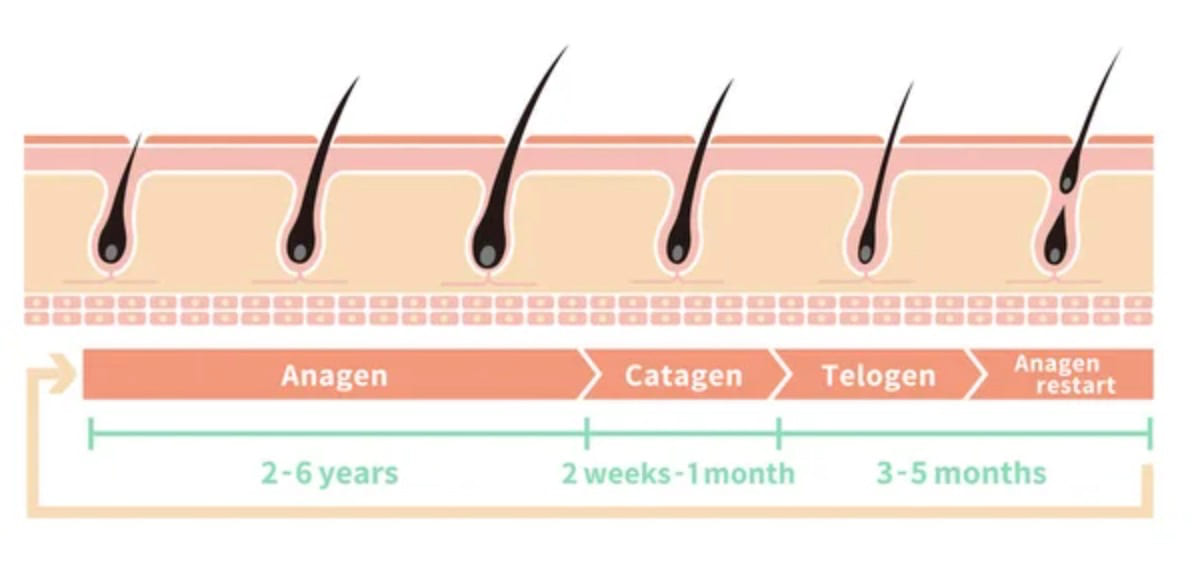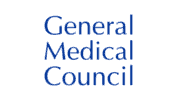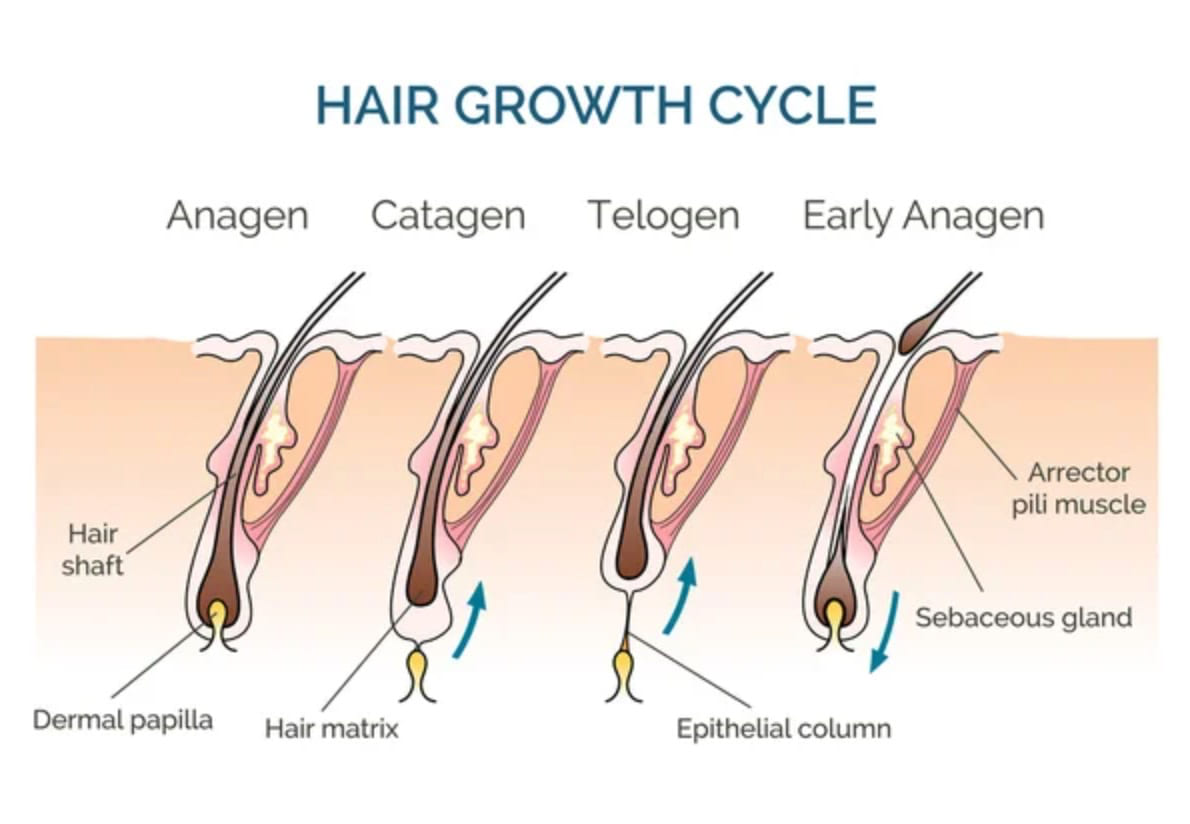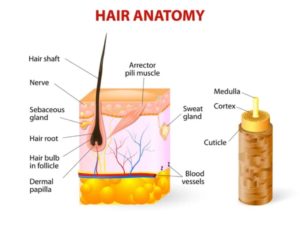The hair growth cycle of human head hair is divided into four key phases:
- Anagen phase
- Catagen phase
- Telogen phase
- Exogen phase (AKA early anagen)
The anagen phase is the longest and most active stage of the hair growth cycle. During this phase, hair grows at a rate of 2-3 inches per month. The catagen phase is a transitional stage between the anagen and the telogen phase. During this phase, hair growth slows down by 50% and may stop altogether. The telogen phase is the shortest and least active stage of the hair growth cycle. This phase lasts for 3-6 months and during this time, hair grows at a rate of 1-2 inches per month. The exogen phase is the final stage of the hair growth cycle. This phase lasts for 6-12 months and during this time, hair falls out and new hair replaces it.

Anagen Phase
The anagen phase of the hair growth cycle is the lengthiest of the four phases and lasts for about two to five years, or until a hair reaches its peak growth rate. During this phase, your hair follicles begin producing new cells (called keratinocytes) in preparation for the new hair’s emergence. This process goes on as long as the hormones that control it are present, which is why men tend to notice their hair growing more quickly than women do, with each passing year.
Catagen Phase
The catagen phase lasts only about a week (or less), during which time your hair follicles become dormant but don’t necessarily start shedding anything immediately. Because this stage occurs so close to anagen (less than one week apart), there will probably still be some visible hair while moving into catagen.
Telogen Phase
At approximately three weeks after the onset of catagen or seven months after your body began producing new cells in anagen (depending upon your age), old hairs enter a resting state called telogen and fall out naturally over two-to-four weeks. These old hairs are replaced with new ones once your body releases them from their resting stage via eccrine glands located around the base of each hair follicle called vellus follicles. These vellus follicles take up roughly 10%–15% of all scalp skin cells and shed several times throughout life without causing any significant issues; however, if you suddenly begin noticing excessive shedding throughout life or after menopause (which would be unusual) you may have alopecia areata.
Exogen Phase
The exogen phase is the final phase of the hair growth cycle, however it’s more of an extension of (or a part of) the telogen phase. This is the phase where hair strands are released from the hair follicles (also known as hair shedding). This can last for as long as 2 to 5 months during which new hairs are growing in the follicles and in essence replace the old ones. You may notice between 50 to 100 hairs fall out during this time, however don’t panic as this is totally normal daily hair loss.
What Can You Do to Try and Maintain Hair Health During These 4 Stages?
Excluding the factors that are beyond your control such as genetics and hormone imbalances, there are certain things that you can do in order to try and keep hair loss at bay as much as possible. To maintain hair health during all four stages, here is some specific info for each stage:
- Anagen phase: This is the growth phase of the hair cycle. To maintain healthy hair during this stage, it is important to eat a balanced diet and get enough sleep. Additionally, it is important to avoid stress and environmental pollutants.
- Catagen phase: This is the transition phase of the hair cycle. To maintain healthy hair during this stage, it is important to avoid tight hairstyles and harsh chemicals.
- Telogen stage: This is the resting phase of the hair cycle. To maintain healthy hair during this stage, it is important to avoid trauma to the scalp and excessive brushing.
- Exogen phase: This is the shedding phase of the hair cycle. To maintain healthy hair during this stage, it is important to eat a balanced diet and take supplements if needed. Additionally, it is important to avoid stress and environmental pollutants.
Nutritional Supplements for Healthy Hair Growth
Some good nutritional supplements to help maintain hair health are ones that contain biotin, iron (especially for women), vitamin C, vitamin D, vitamin B12 folic acid, zinc and omega-3 fatty acids. This is in conjunction to increasing your protein intake as hair is mostly made from protein. See which vitamin deficiency causes hair loss
Good ingredients for extra protein in meals to eat are:
- fish
- beans
- lean meats
- legumes
Reduce/ Try to Minimise Stress
If you’re experiencing stress, your hair may spend more time in the resting phase of the growth cycle. This means that new hair won’t be growing as quickly. To help your hair, it’s important to find ways to manage and reduce stress.
You can always try different techniques and exercises such as yoga, meditation, counselling and breathing techniques to help in your quest to reduce stress!
Hair Care
To have healthy hair, you need to be mindful of the products you use and how you treat your hair. Start by finding shampoos and conditioners that are designed for your hair type, whether it’s oily, dry, fine, colour-treated, etc. You may need to try a few different products before you find ones that work well for you. Be gentle with your hair to avoid damaging it. Use lukewarm water when shampooing and towel-dry your hair gently. Let your hair air dry whenever possible to minimise heat damage.








